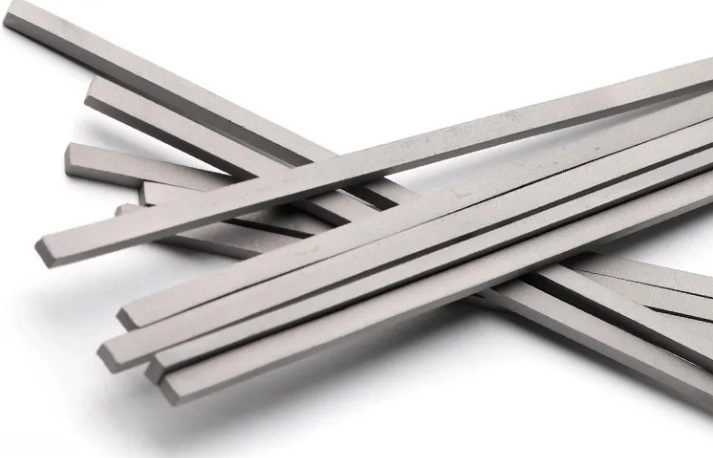他の追随を許さない硬さで摩耗に打ち勝つ:超硬ボタン技術の深層
摩耗、衝撃、侵食が常につきまとう過酷な重工業の世界では、従来の素材では不十分なことが多い。参入 カーバイド ボタン - 最も過酷な条件に耐え、機器の寿命を延ばし、生産性を最大化するために設計された、小さくても力強い戦士たち。
この包括的なガイドブックでは、超硬ボタンの魅力的な世界を掘り下げ、その組成、用途、利点、そして究極の耐摩耗性ソリューションとなる要因を探ります。
超硬ボタンとは?
タフネスの小さな巨人:組成と構造を解明する
超硬製ボタンは耐摩耗性の部品で、通常は円形または六角形をしており、極度の摩耗を受ける工具や機器の表面に戦略的に取り付けられます。通常、超硬合金(タングステンカーバイド)で作られた硬質で耐摩耗性のあるコアを、より強靭で耐衝撃性のあるマトリックス(多くの場合、鋼合金)が取り囲んでいます。

卓越した硬度を支える科学:超硬合金を理解する
炭化タングステンとしても知られる超硬合金は、その卓越した硬度で有名な複合材料であり、鋼や他の多くの摩耗材を大幅に上回ります。超硬合金は、粉末冶金と呼ばれるプロセスで製造されます:
- パウダーの調製: 非常に硬いことで知られる炭化タングステンを微粉末にし、金属バインダー(通常はコバルト)と混合する。
- 圧縮: 混合粉末は高圧で圧縮され、所望の形状に成形される。
- 焼結: 圧縮された部品は、制御された雰囲気の中で高温に加熱され、バインダーが溶けて炭化タングステン粒子を融合させる。
この焼結プロセスにより、非常に緻密で耐久性に優れ、耐摩耗性に優れた複合材料が作られる。
超硬製ボタンの仕組み
摩耗の力に対して強く立つ:耐久性のメカニズム
超硬ボタンの優れた耐摩耗性は、いくつかの重要な要因によるものです:
- 極限の硬さ: 炭化タングステンのコアは、既知の材料の中でも最高レベルの硬度を持ち、硬く鋭い粒子による摩耗に耐えることができます。
- 高い圧縮強度: 焼結プロセスにより、超硬合金内に緻密な相互連結構造が形成され、破断や変形を起こすことなく高い衝撃力に耐える卓越した圧縮強度が得られます。
- タフなアウター・マトリックス: 周囲の鋼鉄マトリックスは、さらなる靭性と耐衝撃性を提供し、過酷な条件下でのカーバイドコアの欠けや割れを防ぎます。
- 安全なアタッチメント: 超硬製ボタンは、一般的にろう付けや溶接によって母材にしっかりと固定されるため、強い応力や振動の下でもしっかりと固定されます。
超硬製ボタンの種類と用途
すべての戦いにボタンを:さまざまな種類と使い方を探る
超硬製ボタンにはさまざまな種類があり、それぞれが特定の摩耗課題や使用条件に合わせて調整されています。一般的なタイプには次のようなものがあります:
- 丸いボタン: 最も一般的なタイプで、耐摩耗性と耐衝撃性のバランスが良い。鉱業、建設、農業などの用途に使用される。
- 六角形のボタン: 表面積が大きいため、耐摩耗性が向上。穴あけや破砕などの磨耗の激しい用途によく使用される。
- 弾道ボタン: 非常に高い耐衝撃性を持つように設計されており、丸みを帯びた形状や円錐形状が衝撃をそらす。ショットブラストや粉砕などの用途に使用される。
- スタッズボタン: 超硬コアと戦略的に配置されたスタッドを組み合わせ、トラクションと耐摩耗性を強化。除雪車や土木機械などの用途に使用される。
超硬ボタンの仕様:主な特性
| 特徴 | 説明 |
|---|---|
| タイプ | 様々(丸型、六角形、バリスティック、スタッド型) |
| コア材 | 超硬合金(タングステンカーバイド) |
| マトリックス材料 | 通常、スチール合金 |
| 硬度 | 通常、85から95 HRA(ロックウェルAスケール)の範囲である。 |
| 圧縮強度 | 通常6000MPa(メガパスカル)を超える |
| サイズと形状 | 幅広いサイズ、形状、取り付け方法(ろう付け、溶接)が可能 |
| グレードと基準 | 多くの場合、メーカーや業界標準(ISO、ASTMなど)に固有のものである。 |
用途超硬製ボタンの活躍の場
要求の厳しい産業における摩耗の克服:主な用途
超硬ボタンの優れた耐摩耗性、耐衝撃性、耐久性は、以下のような幅広い用途に最適です:
- 鉱業だ: 掘削工具、バケット歯、クラッシャー摩耗部品、シュート、ホッパー。
- 建設: 道路切削工具、アスファルトカッター、コンクリートブレーカー、解体機械。
- 農業だ: 耕運機用工具、耕運機部品、農業機械用摩耗部品。
- リサイクル: シュレッダーハンマー、クラッシャー摩耗部品、マテリアルハンドリング部品。
- 石油・ガス ドリルビット、ダウンホールツール、ポンプとバルブの摩耗部品。
超硬ボタンサプライヤーの比較
市場をナビゲートする:主要サプライヤーの比較
| サプライヤー | 所在地 | 価格帯(1個あたり) | 特産品 |
|---|---|---|---|
| ボアート・ロンイヤー | オーストラリア | $10 – $60+ | 鉱業および建設用の掘削工具および摩耗部品 |
| ESCO株式会社 | アメリカ | $8 – $50+ | 建設・鉱業用研削工具および摩耗部品 |
| アトラスコプコ | スウェーデン | $12 – $70+ | 鉱業、建設、インフラストラクチャー用の掘削装置と摩耗部品 |
注: 価格はおおよそのものであり、ボタンのサイズ、グレード、注文数量、その他の要因によって大きく異なる場合があります。
超硬製ボタンの長所と短所
長所と短所を天秤にかける:バランスのとれた視点
| メリット | デメリット |
|---|---|
| 優れた耐摩耗性 | いくつかの代替品に比べ、イニシャルコストが高い |
| 高い耐衝撃性 | 特定の衝撃条件下では脆くなることがある |
| 様々な用途に対応する汎用性 | 適切な取り付けには、特殊なろう付けまたは溶接技術が必要な場合がある。 |
| 長寿命でメンテナンスとダウンタイムを削減 | 性能は適切なグレードの選択と運転条件によって決まる |
基本を越えて:超硬ボタンに関する興味深い事実
- 電球からウェア保護まで: 白熱電球のフィラメントに使われているタングステンと同じ素材が、超硬ボタンの並外れた硬度の基礎となっている。
- グローバル市場: 超硬ボタンの世界市場は、鉱業、建設、インフラ開発などの産業からの需要増に牽引され、大きく成長している。
- 絶え間ない革新: メーカー各社は、性能、寿命、アプリケーションの可能性をさらに高めるため、常に新しい超硬合金グレード、ボタン設計、取り付け方法を研究開発しています。
超硬ボタンにTRUERを選ぶ理由
TRUERは、高性能な超硬ボタンソリューションを提供する信頼できるパートナーです。ご提供いたします:
- 妥協のない品質: 当社では、厳格な品質管理で知られる定評あるメーカーから超硬ボタンを調達し、一貫した性能と信頼性を確保しています。
- オーダーメイドのソリューション 当社の専門家チームは、お客様と緊密に連携して具体的なアプリケーション要件を理解し、最適な超硬グレード、ボタン設計、および取り付け方法を推奨します。
- 競争力のある価格設定: 品質に妥協することなく、競争力のある価格設定に努め、お客様に最高の価値をお届けしています。
- 卓越したカスタマーサポート: お客様にご満足いただくための当社の取り組みは、販売にとどまりません。お客様が超硬ボタンの性能と寿命を最大限に発揮できるよう、技術サポート、指導、支援を提供しています。
超硬ボタンに関するよくある質問
1.用途に適した超硬材種はどのように選べばよいですか?
最適なグレードは、関連する特定の摩耗メカニズム、加工材料、および使用条件によって異なります。超硬ボタンサプライヤーや材料科学の専門家に相談し、オーダーメイドの推奨を受けることをお勧めします。
2.超硬ボタンにはどのような取り付け方法がありますか?
一般的な取り付け方法には、ろう付けと溶接がある。ろう付けでは、フィラーメタルを使ってボタンを母材に接合し、溶接では熱と圧力を使って材料を融合させる。
3.超硬ボタンの寿命を延ばすには?
適切な取り扱い、保管、洗浄、メンテナンスの実施、および運転パラメーターの最適化により、ボタンの寿命を大幅に延ばすことができます。
4.摩耗防止用の超硬製ボタンに代わるものは?
代替品としては、ハードフェーシング合金、セラミックタイル、ポリウレタンコーティングなどがあります。しかし、多くの場合、超硬ボタンは、要求の厳しい用途において、優れた耐摩耗性、耐衝撃性、および全体的な寿命を提供します。
5.信頼できる超硬ボタンのサプライヤーはどこにありますか?
TRUER は、高品質の超硬ボタンの信頼できる供給元です。お客様の具体的なご要望をお聞かせいただき、当社の包括的なソリューションをご検討ください。




